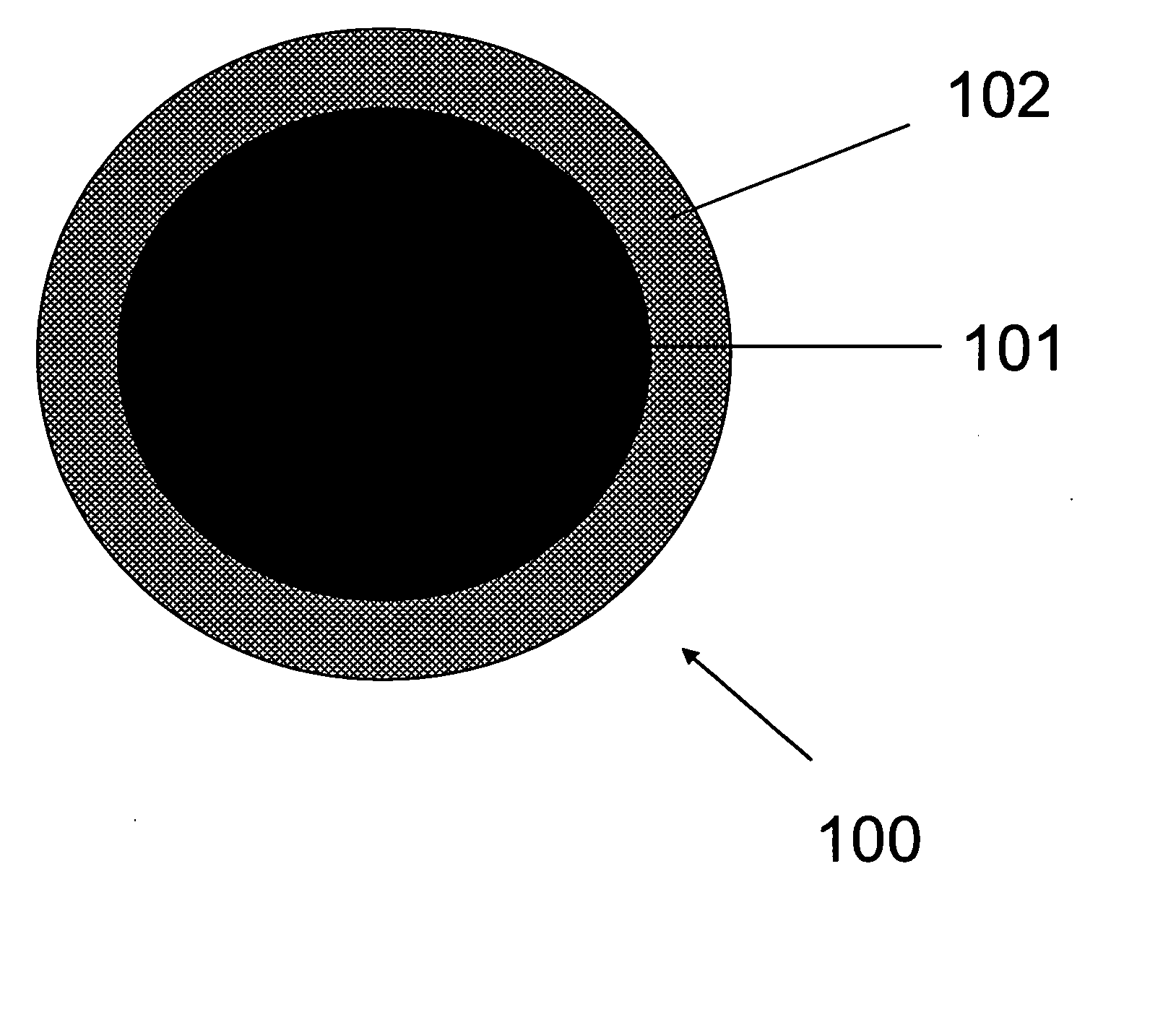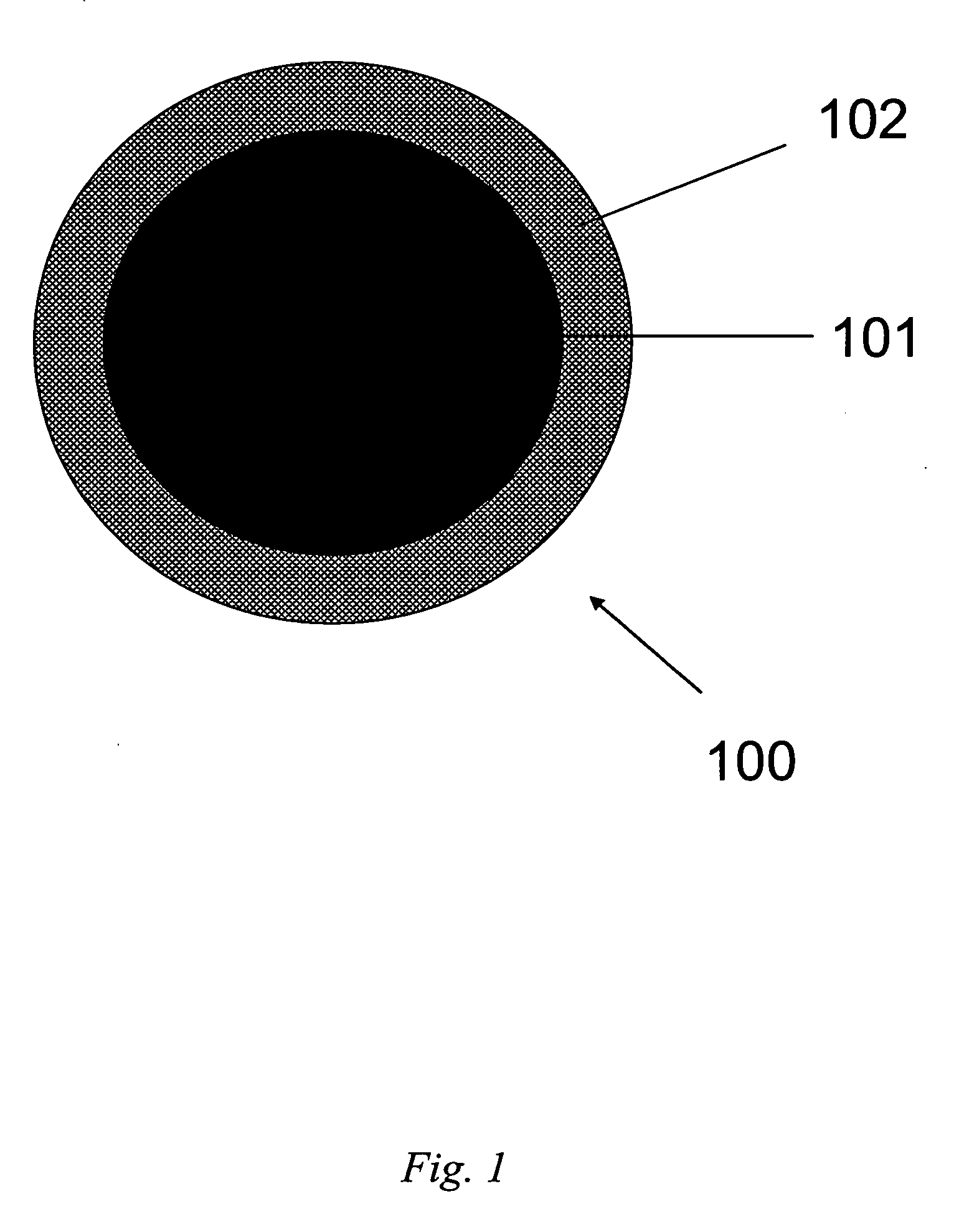Nanoparticle-based imaging agents for X-ray/computed tomography
a technology of computed tomography and imaging agents, applied in the direction of pharmaceutical delivery mechanism, powder delivery, pigment treatment with organosilicon compounds, etc., can solve the problems of difficult to target these agents to disease sites, difficult to achieve robust synthesis and stability of oxidation, and not very cost-effective
- Summary
- Abstract
- Description
- Claims
- Application Information
AI Technical Summary
Benefits of technology
Problems solved by technology
Method used
Image
Examples
example 1
[0048] This Example serves to illustrate how a first type of CT imaging agent can be prepared, in accordance with some embodiments of the present invention. In this particular Example, the CT imaging agent comprises an active shell of triiodobenzene-based ligand linked to a passive core such as poly(styrene) or iron oxide nanoparticles.
Synthesis of the Passive Core
[0049] A 25 mL, 3-neck Schlenk flask was fitted with a condenser, stacked on top of a 130 mm Vigreux column, and a thermocouple was introduced. The condenser was fitted with a nitrogen inlet and nitrogen flowed through the system. The Schlenk flask and Vigreux column were insulated with glass wool. Trimethylamine N-oxide (TMAO) (0.570 g, 7.6 mmol) and oleic acid (OA) (0.565 g, 2.0 mmol) were dispersed in 10 mL of dioctylether (OE). The dispersion was heated to 80° C. at a rate near 20° C. / min. Once the mixture had reached 80° C., 265 μL of Fe(CO)5 (2.0 mmol) was rapidly injected into the stirring solution via the Schlen...
example 2
[0057] This Example serves to illustrate how a second type of CT imaging agent can be prepared, in accordance with some embodiments of the present invention. In this particular Example, an active shell comprising triiodobenzene-based covalent ligands is linked to an active core of hafnium oxide.
Synthesis of the Active Core
[0058] Hafnia nanocrystals (HfO2) may be prepared from a suspension of hafnium oxychloride in ethanol. An organosilane-based coating may be applied as follows: dilute 3-glycidoxypropyl(trimethoxysilane), GPTS, using butanol (volume ratio 1:0.5) and perform a pre-hydrolysis step by addition of 0.1M HCl keeping the molar ratio of GPTS:H2O at 1:0.5. Subject the resulting solution to vigorous stirring overnight at room temperature, then load with the HfO2 nanocrystals. See Ribeiro et al., Appl. Phys. Lett. 2000, 77 (22), 3502-3504. FIG. 7 is a TEM image of an active core largely comprising hafnium oxide, in accordance with some embodiments of the present invention. ...
example 3
[0061] This Example serves to illustrate how a third type of CT imaging agent can be prepared, in accordance with some embodiments of the present invention. In this particular Example, a passive shell linked to an active core of hafnium oxide.
[0062] Hafnia nanocrystals (HfO2) may be prepared from a suspension of hafnium oxychloride in ethanol (see EXAMPLE 2). An organosilane-based coating may be applied as follows: dilute 3-glycidoxypropyl(trimethoxysilane), GPTS, using butanol (volume ratio 1:0.5) and perform a pre-hydrolysis step by addition of 0.1M HCl keeping the molar ratio of GPTS:H2O at 1:0.5. The resulting solution is subjected to vigorous stirring overnight at room temperature, then loaded with the HfO2 nanocrystals. See Ribeiro et al., Appl. Phys. Lett. 2000, 77 (22), 3502-3504. FIG. 8 is a TEM image of active core / passive shell nanoparticles comprising a tungsten oxide core and polymeric shell, in accordance with some embodiments of the present invention.
PUM
| Property | Measurement | Unit |
|---|---|---|
| thickness | aaaaa | aaaaa |
| diameter | aaaaa | aaaaa |
| diameter | aaaaa | aaaaa |
Abstract
Description
Claims
Application Information
 Login to View More
Login to View More - R&D
- Intellectual Property
- Life Sciences
- Materials
- Tech Scout
- Unparalleled Data Quality
- Higher Quality Content
- 60% Fewer Hallucinations
Browse by: Latest US Patents, China's latest patents, Technical Efficacy Thesaurus, Application Domain, Technology Topic, Popular Technical Reports.
© 2025 PatSnap. All rights reserved.Legal|Privacy policy|Modern Slavery Act Transparency Statement|Sitemap|About US| Contact US: help@patsnap.com



